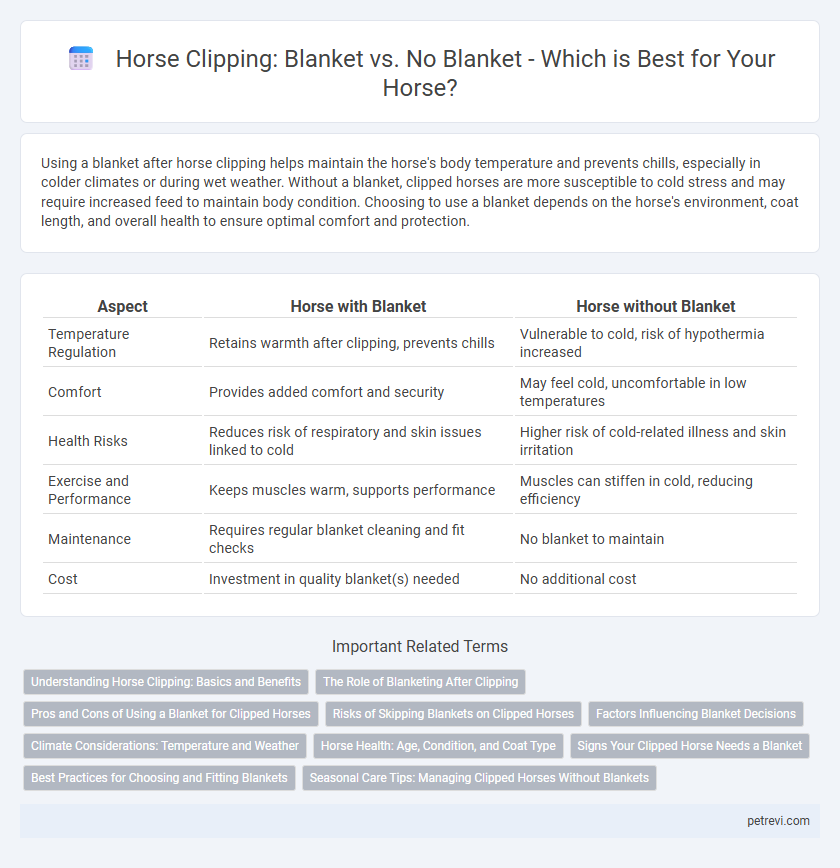Using a blanket after horse clipping helps maintain the horse's body temperature and prevents chills, especially in colder climates or during wet weather. Without a blanket, clipped horses are more susceptible to cold stress and may require increased feed to maintain body condition. Choosing to use a blanket depends on the horse's environment, coat length, and overall health to ensure optimal comfort and protection.
Table of Comparison
| Aspect | Horse with Blanket | Horse without Blanket |
|---|---|---|
| Temperature Regulation | Retains warmth after clipping, prevents chills | Vulnerable to cold, risk of hypothermia increased |
| Comfort | Provides added comfort and security | May feel cold, uncomfortable in low temperatures |
| Health Risks | Reduces risk of respiratory and skin issues linked to cold | Higher risk of cold-related illness and skin irritation |
| Exercise and Performance | Keeps muscles warm, supports performance | Muscles can stiffen in cold, reducing efficiency |
| Maintenance | Requires regular blanket cleaning and fit checks | No blanket to maintain |
| Cost | Investment in quality blanket(s) needed | No additional cost |
Understanding Horse Clipping: Basics and Benefits
Horse clipping involves trimming a horse's coat to regulate body temperature and improve comfort during exercise, especially in colder months. Using a blanket after clipping helps maintain the horse's warmth, prevents chills, and supports the immune system by reducing stress on the body. Choosing between a blanket or no blanket depends on factors like the horse's indoor shelter, activity level, and climate conditions to ensure optimal health and performance.
The Role of Blanketing After Clipping
Blanketing plays a crucial role in maintaining a clipped horse's body temperature and preventing chills, especially in colder climates or during damp weather. Without a blanket, a clipped horse may lose heat rapidly due to the lack of natural insulation from its coat, increasing the risk of illness and discomfort. Proper blanketing ensures optimal thermoregulation, supports recovery, and enhances overall equine health post-clipping.
Pros and Cons of Using a Blanket for Clipped Horses
Using a blanket for clipped horses provides essential warmth and protection against cold weather, reducing the risk of chill and illness. However, blankets can cause overheating if the horse is exercised heavily or the temperature rises, and improper fitting may lead to discomfort or skin sores. Choosing the right material and fit is crucial to balance warmth with breathability, ensuring the horse's comfort and health throughout varying conditions.
Risks of Skipping Blankets on Clipped Horses
Clipped horses without blankets face increased risks of hypothermia and muscle stiffness due to loss of their natural insulation. Exposure to cold and wet conditions can also lead to respiratory infections and decreased immune function. Proper blanket use is essential to maintain body temperature and protect skin health after clipping.
Factors Influencing Blanket Decisions
Horse clipping often necessitates a blanket to maintain body temperature as clipped coats lose natural insulation. Key factors influencing blanket decisions include ambient temperature, wind conditions, and the horse's health status or metabolic rate. Owners must also consider the horse's activity level and whether it has access to shelter when deciding to blanket after clipping.
Climate Considerations: Temperature and Weather
Clipping horses in colder climates often necessitates using a blanket to maintain body warmth and prevent chill stress, especially when temperatures drop below freezing or during rainy, windy weather. Horses without blankets in such conditions may experience reduced immunity and slower recovery, increasing the risk of respiratory or muscular issues. In warmer regions or mild weather, leaving horses unclothed after clipping can help prevent overheating and allow natural thermoregulation through sweating.
Horse Health: Age, Condition, and Coat Type
Blanketing a clipped horse significantly impacts its health based on factors like age, overall condition, and coat type. Older horses or those in poorer health benefit from extra warmth provided by blankets, as their natural ability to regulate body temperature declines. Horses with thinner coats or those clipped heavily require blankets to prevent hypothermia and maintain optimal body condition during cold weather.
Signs Your Clipped Horse Needs a Blanket
Clipped horses often show signs of discomfort such as shivering, reluctance to move, or seeking shelter, indicating a need for a blanket to maintain body heat. Monitor changes in their coat condition and energy levels, as a clipped horse without sufficient warmth may exhibit weight loss or decreased appetite. Proper use of a blanket helps prevent cold stress and supports recovery, especially in harsh weather or for horses with thin skin or low body fat.
Best Practices for Choosing and Fitting Blankets
Choosing the right blanket after horse clipping depends on factors such as climate, horse breed, and coat thickness to maintain optimal body temperature and prevent chills. Best practices for fitting blankets include ensuring a snug fit without restricting movement, checking for proper coverage over the withers and shoulders, and avoiding pressure points that can cause discomfort or sores. Regularly monitoring the horse's condition and adjusting blanket layers as weather changes enhances comfort and health post-clipping.
Seasonal Care Tips: Managing Clipped Horses Without Blankets
Clipped horses require careful management during colder seasons to maintain their body temperature and prevent chills. Providing adequate shelter, increasing feed rations to support energy needs, and ensuring access to fresh water are crucial for clipped horses without blankets. Regular grooming helps stimulate circulation and remove sweat, reducing the risk of skin irritation and promoting overall health during winter months.
Blanket vs No Blanket for Horse Clipping Infographic

 petrevi.com
petrevi.com